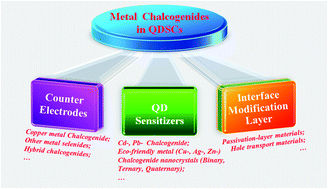As one of the most promising third-generation photovoltaics devices, quantum dot-sensitized solar cells (QDSCs) have attracted increasing attention due to their easy fabrication, low cost, potential high efficiency, etc. Thus, substantial efforts have been taken to boost their photoelectrical conversion efficiencies (PCEs) and device stability consistently by precisely optimizing the structure of materials and device architecture. Throughout the development of QDSCs, it is noteworthy to mention that metal chalcogenide-based semiconductors have been key materials in capturing sunlight as sensitizers, catalytic electrolyte reduction as counter electrodes (CEs), and interface charge transport as interface modification layers. Herein, we systematically review the recent progress on metal chalcogenide-based QDSCs in practical applications from three main functional points, specifically, QD sensitizers, counter electrodes (CEs), and interface modification layers. Besides, we have outlined the fundamental structure, operation principle, and brief history of these sensitized solar cells. Finally, the state of existing challenges and future prospects for QDSCs employing various metal chalcogenides are also discussed.
